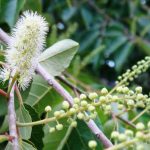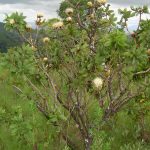TREE LIFE
AUGUST 1988
HARARE CALENDAR
Saturday, 6th August: Botanic Garden Walk. Meet in the Car Park at 1045 for 1100 hours.
Sunday, 21st August: Borderlands Estate / Wittlands, Roma /Goromonzi, the property of Mr & Mrs Julian Long’s is our August venue. Last Tree Life was a little misleading. The venue is not actually Dr. Cock’s although he is somehow connected. Vegetatively the site is richly endowed, having riverine and kopje habitats with at least 72 tree species recorded on the recce. There is apparently also a fair bit of rock art to be seen. As the venue is quite close to Harare, it was decided not to take a coach but to share transport and go in own cars instead, meeting at the RV at 10.00 am.
Saturday 27th August : Mukuvisi Woodlands Meeting. Please meet at 1500 hours at Paget Road/Inyanga Crescent gate.
Tuesday 6th September: Botanic Garden Walk. NB reverting to evenings with advent of summer.
MATABELELAND CALENDAR
0n Sunday, August 7th we will go to the Khami area. Meet just beyond Modern Motors on the Khami road at 0830 hours. This will be a shorter outing.
0n Sunday September 4th we go to Inyankhuni Dam. Meet at Ascot Car Park, at 0830 hours. This is a longish drive, a day trip. Also on the second Sunday September 11th we can join the Aloe & Cactus Society for an interest trip to Mangwe
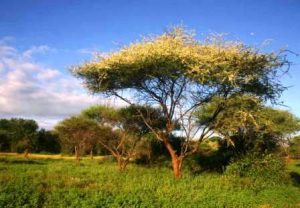
Acacia tortilis. Photo: Bart Wursten. Source: Flora of Zimbabwe
On Sunday July 3rd, we went to the Matopos first just beyond the Arboretum, then to the lower Outspan, where we had an identification test. Results were better than expected though most of us, (including myself) made some silly errors.
During the morning, we identified some 60 species; first we paused at a patch of Acacia tortilis. Apparently the road had been used for cattle droving, as along it at intervals there are similar patches, no doubt at outspans. A. tortilis is not otherwise in the area. The pods must have been eaten, as the thorns are fierce. The Haak-en-Steek was very obvious. Then we had an excellent talk on Euphorbia cooperi and the differences with E. ingens, well indicated by Norma Hughes.
Other Acacias seen were A. gerrardii, A. karroo, A. rehmanniana, A. robusta, Albizia amara and A. harveyi grew alongside each other, so we noted the dark bark and sickle-shaped leaflets of A. harveyi opposed to the smaller straight ones of A. amara, Allophylus africana was contrasted with Rhus lancea and R. leptodictya; Brachylaena rotundata, Bridelia mollis not unlike the widespread Pterocarpus rotundifolius, Combretum apiculatum with Colophospermum mopane, quite a few Cordia grandicalyx, very sandpapery leaves, Commiphora marlothii, C. mollis many squared stems, C. africana or C. schimperi all being leafless, Euclea divinorum, E. natalensis, Ficus ingens, F. salicifolia, Gardenia volkensii, Grewia flavescens, G. monticola much taller than usual, Heteropyxis dehniae, Lannea discolor with few leaves very far away, Maytenus heterophylla subsp. puberula, the small leaved Matopos edition, Mimusops zeyheri with much milky latex and leaf batches falling in waves, Olea europea, subsp. africana, Pterolobium stellatum reddening the roadside, Strychnos matopensis with its climber’s hooks and orange fruit, Terminalia randii dark red and handsome, fortunately with young Terminalia fruit to solve our confusion.
-C. SYKES
NEW COMMITTEE
Although we gave a run-down on the AGM in the last Tree Life we neglected to advise members of the Committee which was voted in. The Committee for 1988/1989 is :
CHAIRMAN : Dick Hicks
VICE CHAIRMAN : Meg Coates Palgrave
SECRETARY : Maureen Silva-Jones
TREASURER :. Joy Killian
MEMBERS: Vida Siebert; Gilbert vanderetichelen; Kim Damstra; Philip Haxen
Sunday, 17th July, 1988 : OUTING TO EIRENE FARM, MARONDERA
“In my Cathedral the candles are lit by the sun ” – Jim Reeves,
How else can I describe the proliferation of tall and striking Aloe excelsa that met our eyes round each corner of the winding road leading to the dam on Eirene, Farm. Each one seemed taller than the other, their lovely inflorescences like nature’s candelabrum – reaching into the sunlight with red and golden flames alight. With gleam of sunlight on the water through the trees as we neared the dam wall, the mood was set for this warm mid-winter’s day.
The promise of sunshine had also encouraged a full complement of Tree Society members and we were happily joined by some of our old friends from Marondera. With the advent of “Aloe 88” it was a pleasure to have as a guest Mr. Ernst Van Jaarsveld, who had come up from Kirstenbosch to deliver two lectures the following week. He was a most interested and interesting guest.
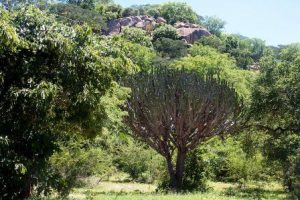
Euphorbia ingens. Photo: Bart Wursten. Source: Flora of Zimbabwe
The dam is built between two kopjes and we began our ramble, up through the Aloe excelsa to the top of one of them. Though Aloes were dominant Euphorbia ingens (the candlebra tree) were also much in evidence growing as tall as the Aloes and so often cheek by jowl with them. Only an Aloe could cuddle up to a Euphorbia. The life span of the Euphorbia ingens, we heard, was about 60 years as those in Kirstenbosch of that age were now dying and this was confirmed by Father Ross who said that those which had been planted at St. George’s College about 60 years ago were also dying out.
The Aloe excelsa is known as “inhlaba” to the traditional healers who use succulent plants with many trees and plants in their medicines. Amongst the medicinal uses for A. excelsa is a “green leaf infusion for dog flu” and as “a purgative” and as “part of treatment for venereal diseases”. They also believe there are male and female aloes, male plants having more spines on their leaves than female plants! Talking of male and female, we found some beautiful Pittosporum viridiflorum with an abundance of yellow capsules, which revealed the sticky resin-covered red seeds when opened; in the afternoon we found a splendid tree without a single berry – a lonely male perhaps? Other riverine species were growing high on the kopje, such as Mundulea sericea, generally associated with underground sources of water and Rhus tenuinervis (commiphora rhus) with delicate net veining in the leaves, hence its name. Rhus leptodictya (rock rhus) had also found an ideal habitat on the granite kopjes and the vivid green leaves of the Tricalysia angolensis brightened the landscape.
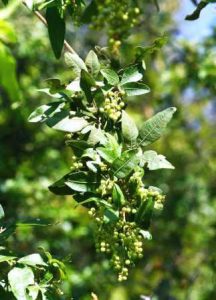
Rhus quartiniana. Photo: Bart Wursten. Source: Flora of Zimbabwe
Climbing to the top we walked through a grove of A. excelsa with a soft carpet of leaves and made our way down the other side to a small sandy beach where the extent of the dam could be seen more clearly. In the dam’s first season of filling the skeletons of the many trees which had been ‘drowned’ were still much in evidence. The way back along the rocky edge of the lake was hazardous but it was a choice of carry on or go back over the kopje, and so we slipped and scrambled over the rocks until we reached the dam wall, passing through a harsh and ghostly forest of Euphorbia with no under cover whatsoever. What a contrast to the top of the kopje. But we were rewarded with the sight of a clump of Aloe cryptopoda in flower high on the bank, once again in typical habitat, being granite hills. During the afternoon we found our way over the granite rocks once more to the river below the dam wall and found there many of the typical riverine species, the Combretum erythrophyllum (cats claws), the Salix mucronata (formerly sub serrata) (wild willow), the Myrica serrata (soap or water berry), Rhus quartiniana, the river Rhus and Ziziphus mucronata. No walk is complete without sight of an Acacia, and we found four species, Acacia karroo (dark red brown bark and sickle pod), A. sieberiana (corky yellow bark), A. rehmanniana with delicate fine leaves and the most exciting one of the lot, A. nilotica with an abundance of lovely pods resembling a string of beads.
A walk back along the road ended our day, very enjoyable but, as always, a little bewildering with so many different trees to think about. At these times it would be fitting to join with the Cape Turtle Dove in his little song of “mompara mompara”.
-Dick Hicks
HIPPO POOLS – MAZOWE RIVER, July 2nd 1988
Following hard on the heels of the Society’s very successful trip to Chirundu the first weekend of July saw us visiting the Hippo Pools Camp on the Mazowe River in the Umfurudzi Safari Area. What a lovely spot in which to spend a weekend (I certainly wish it could have been longer) and what a variety of trees we saw.
We arrived in dribs and drabs having taken longer than we had anticipated as the last section of the road from Madziwa mine had to be taken slowly. Soon after arrival and while enjoying rock-buns and coffee Maureen also presented us with the list of trees recorded when they visited the area last Christmas. This contained 102 names, The first afternoon we recorded 84 tress adding another 19 names to the list and next morning a further 13 were added so that the list now comprises 134 species of which we saw 104 different trees. Those are the numeric statistics and give no indication at all of the quality, if quality can be measured by trees we do not often see. I will be mentioning several species which I believe have seldom if ever been included in the newsletter before.
The camp is situated on a very well treed terrace about 3 m above, and overlooking the Mazowe River. The trees were big and still in leaf. There was one with a distinctive bark, unlike that of any of the others, so tall that we needed the binoculars to identify it. An easy matter once we had spotted the paired pods as that immediately led us to be family APOCYNACEAE, which, usually, also has simple opposite leaves and a milky sap. This member was Holarrhena pubescens, Jasmine tree, with very slender pods. Not to be confused with the Pink Jacaranda, Stereospermum kunthianum growing fairly close by, which also has long thin pods, but these are borne singly and are not as narrow. The grey bark flaking off in large pieces revealing a paler grey to yellow under bark is quite distinctive. This is a member of the BIGNONIACEAE family and has compound or pinnate leaves which are opposite, an unusual feature for plants with pinnate leaves. Bauhinia petersiana, white Bauhinia with its butterfly-like leaves was prevalent and so was Artabotrys brachypetalus, Purple hookberry, unmistakable with its “hooks”. The shiny green leaves, alternate, but on opposite sides of the branchlets, so all in one plane, are typical of the family ANNONACEAE. The hooks are the peduncles, or stalks which bear the flowers, but are also used as grappling hooks.
Growing close enough together for us to compare them were Grewia monticola, its ovate leaves with a very leathery texture and an asymmetric, cordate base easily distinguishable from the Grewia bicolor with narrower leaves, thinly to smoothly textured and an almost symmetric base. They were also, distinct enough to be their own species. There is presently recorded a species called Grewia sub. spathulata which appears to be halfway between G. bicolor and G. monticola. The leaves are more like G. bicolor in shape but are more leathery in texture and have a distinctly asymmetric base. Although given the name G. sub spathulata it seems probable that this will turn out to be a hybrid although, apparently, a fertile one. Breeding trials will be necessary to determine whether there are three species, or two species and a hybrid.
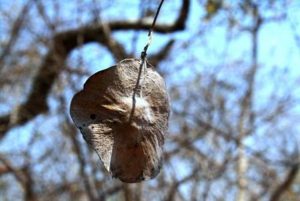
Pterocarpus brenanii. Photo: Bart Wursten. Source: Flora of Zimbabwe
We wandered along the road as walking was easier and there was plenty to see. There a Pterocarpus brenanii, large-leaved Bloodwood, which could perhaps also be called the Eared Bloodwood. This species is distinguishable by the large leaf-like, stipules (appendages at the base of the petiole) which curl round the stem and remain on the tree for most of the year. The leaves look like a very large version of P. rotundifolius and so do the pods which we found the next day. These trees are found in hot dry areas including at Kariba in front of the Carribea Bay Hotel.
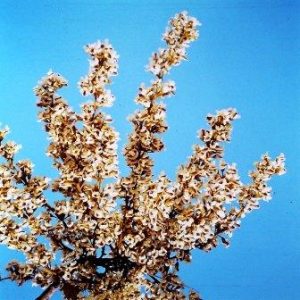
Dalbergiella nyassae. Photo: Bart Wursten. Source: Flora of Zimbabwe
Dalbergiella nyassae, Mana-pod, is a tree we saw -previously in flower; during our trip to the Alpha Trail two years ago. They also grow in warmer areas at lower altitudes and are common round Makuti and Marangora. The leaves are all bunched together forming big tufts. Closer examination shows that they are compound with 6 to 9 pairs of opposite to sub-opposite leaflets plus a terminal one (imparipinnate). The leaflets are bluish green, oval to oblong, rounded at the apex and base and the margin is slightly rolled under. The backs of the leaflet-stalks, or petiolules, are a velvety rusty brown. The pods remain on the trees for some months and are distinctive, flat with a slight dent down one edge where the fringe of hairs can be seen even though they may have fallen off from round the edge of the rest of the pod.
We were able to identify Commiphora mossambicensis Pepper-leaved Commiphora in its leafless form. The dry leaves were on the ground all round the tree. They are usually trifoliolate and the leaflets have a very characteristic shape being more or less round with the apex drawn in to a point. The bark is smooth grey with a definite pink tinge and although the branchlets are spiky they are not spine-tipped. The tree still had some fruit on and we were able to pop off the outer thick fleshy skin leaving the black seed with the four lobes of the red pseudaril clasping it. There was a Crossopteryx febrifuga, crystal-bark, but we were unable to find any crystals. On previous occasions, we have found that the bark at the base of the trees flakes off in pieces and we have sometimes been able to see crystals on the inside of the pieces. This bark seemed very finely scaly with none peeling off so we tried a flick-knife but were unable to find any. We did not try stripping the dry bark from a branch. As a member of the RUBIACEAE family the leaves are opposite with interpetiolar stipules which are reasonably persistent so we were able to see them easily. The leaves are elliptic (like a rugby-ball) with very short, pink tinged petioles. There were some bunches of fruit on the tree. The fruit are elongated pea-sized capsules which split in half releasing seeds with a fringed margin hence the name from “krossoi” fringe and “pteron” wing
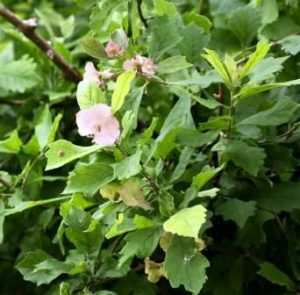
Holmskioldia tettensis. Photo: Bart Wursten. Source: Flora of Zimbabwe
We then wandered through the grass to a rocky outcrop with little patches of an Aloe chabaudii in flower, and lots of trees of interest. Commiphora pyracanthoides was recognizable as a Commiphora, once again leafless, but it had spine-tipped branchlets and we were able to find one or two dry leaflets. This species has a compound leaf with a single leaflet although occasionally two tiny leaflets can be found joined to the big one. Holmskioldia tettensis, Wild Chinese Hats, has a very distinctive leaf with the upper third of the margin roughly toothed or lobed (one or two on either side of the apex) Holmskioldia sanguinea is the Chinese Hat often grown in gardens come from the foot hills of the Himalayas in India. Manilkara mochisia with the leaves in rosettes at the end of short, stubby, leaf-scarred-branchlets is another tree we do not often see. There was also a tree which puzzled me for some time. I eventually decided that it was Diospyros squarrosa and this has now been confirmed. The leaves are fairly pale green with yellow lateral veins, very regular at 15 degrees to the midrib. The net veining was also distinct as it is in D. mespiliformis and D. kirkii, which were very common in the area.
There was no evidence of any elephant, let alone in large numbers, so it was of interest that there were many clumps of stunted Hyphaene petersiana (formally benguellensis), Northern Ilala Palm. Often elephant are blamed for these palms being stunted. Palms are Monocotyledons like the grasses and so do not really develop trunks with secondary thickening like trees which are Dicotyledons. A long time is spent making a trunk before it is pushed up with a crown of leaves on top. We came upon a dried up pan with two clumps on on either side, some of which had started growing up and had stems of over a meter high.
We then wandered through beautifully developed woodland with tall trees forming a canopy high overhead. Some with very pale trunks caused us to pause and ponder awhile. Perhaps as we so often see these as isolated trees, having been left when the surrounding trees were felled, we had difficulty in recognizing Pericopsis angolensis, Mwanga growing in woodlands.
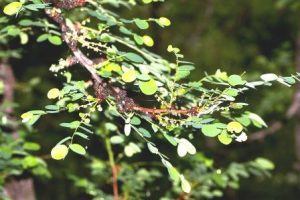
Phyllanthus engleri. Photo: Bart Wursten. Source: Flora of Zimbabwe
Probably for me, the highlight of the trip was seeing Phyllanthus engleri, spurred Phyllanthus. I have read about it, there is a drawing in the book done from a Herbarium specimen, there is one growing in the Botanic Garden but Paul and I always wanted to see one growing in the wild. It was no disappointment at all. The spurs were all I wanted them to be. This very fascinating tree bears simple leaves on green deciduous branchlets that look for all the world like compound leaves. The deciduous branchlets grow from woody prickly spur shoots and leave scars when they fall off, so with the passage of time the spur shoots get thicker and longer. This first tree was obviously female as it was also in green fruit, 6 lobed and characteristic of the EUPHORBIACEAE family.
Our return trip was along the riverbank, beneath some tall thick-trunked and rather atypical Acacia polyacantha; next to patches of Ficus capreifolia, River Sandpaper, with, as the name suggests, very harsh leaves. The Maytenus we saw was M. heterophylla and not M. senegalensis as we thought at the time. We have been having a bit of trouble distinguishing between these two recently. The differences seem to be : M. heterophylla – prefers slightly moister areas; young shoots green, usually angular or slightly lined; leaves usually green not blue-green, very variable in size, rarely mottled when dry; leaf margins densely finely together; flowers separate male and female trees; 3-locular ovary and yellow to red capsules. M. senegalensis – can grow in more arid areas where it does look a bit different; shoots unlined, flattened becoming round, reddish or blue green; leaves rarely elliptic, blue green, often mottled at least when dry; leaf margins notched with very small blunt or rounded teeth; flowers bisexual; 2-locular ovary, capsule pink to deep red.
There was Salix mucronata, wild willow almost in the water. That represents another name change and the other one to which we were trying to adapt was Combretum adenogonium the new name for the species we have previously called C. fragrans. Whatever the name they were quite beautiful in their autumn colours.
The beer, braai and bed were a very good end to a very good day. Our thanks to Dick and Maureen for organizing the venue. I really found it very exciting and would love to go back again.
-Meg Coates Palgrave.
Sunday, 3rd July
We were awakened at 6 am by the cry of the Fish Eagle and although the air was mild, we warmed ourselves at the embers of the braai fire. The kettle was soon on the boil for tea. A family of guinea fowl was about the days business on a sandy spit across the river Mazowe. A single Egyptian Goose gave rise to some romantic and perhaps sorrowful conjecture on its loneliness without its mate. Later we saw a pair of geese in flight so perhaps the lost lover had returned.
We set off in single file along the banks of the river tutored by Meg, Phil and Dick. We identified many of the trees including Rhus quartiniana or River Rhus, with its distinctive smell, Ziziphus abyssinica, Ficus sycamorus and Artabotrys brachypetalus with its quilted leaves. Others included the Tamarindus indica, which evokes memories of Julie Andrews or Omar Sharif depending on the gender of the onlooker, Strychnos potatorum, Lecaniodiscus and Dalbergia melanoxylon which is used for carving the black animals seen in curio shops. Just before turning from the bank we saw Garcinia livingstonei (Dick had searched high and low for it having spotted it on a previous trip) and Azanza garckeana. On the previous day we had been disappointed not to see any Hippo but now we saw one almost submerged watching us intently from the river. There was plenty of evidence of Hippo and all kinds of Buck but we saw none. Perhaps we were making too much noise.
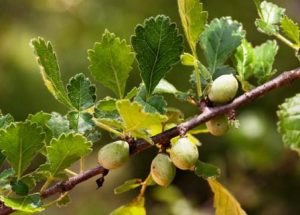
Commiphora africana. Photo: Bart Wursten. Source: Flora of Zimbabwe
And so into the woods! Almost immediately we were rewarded with the sight of a very large Strychnos madagascariensis and a huge Sclerocarya birrea more than two standard “Meg hugs”. From the large to the very small, we inspected the delicate skeleton of a leaf with its lace like veins, possibly the victim of a caterpillar. The trees we came across included Acacia goetzei, Ximenia caffra with its blue/green furry leaf. Commiphora africana and Sterculia quinqueloba with its peeling bark. We became familiar with Bridelia cathartica, Pterocarpus brenanii with its pronounced leaf-like stipule and Terminalia stenostachya with its leaves in rosettes at the ends of its branches. We also saw Diospyros kirkii in fruit, said to be good to eat, and Gardenia ternifolia.
We reached a gravel road and walked up it until we came to a kopje where we saw a Baobab (Adansonia digitata) and a large and beautiful Euphorbia cooperi in flower.
Dick showed us why the Dalbergiella nyassae can be called Mana Pod from the small fibres along its spine resembling a donkey’s mane. Some of us climbed the kopje for no better reason than to get to the top, and were rewarded with a magnificent view over the valley. Near the summit were several Croton gratissimus and the Commiphora marlothii with its paper – like bark.
Meanwhile the main party had returned to camp via the woodlands while the kopje climbers were following the road. With only one slight detour on the way back, to wonder at huge boulders of dolorite, tumbling down a water course, the banks dotted with aloes in full flower. By the time we arrived back at the chalets it was time to think of lunch (or was it breakfast – no one seemed quite sure). Sleeping lazily on the sandy spit was a small crocodile and the guinea fowl were foraging again. We knew we had to leave soon but were reluctant to be the first to move away from this lovely spot.
-Kathy Withers
There were a couple of tree highlights the next day, only confirmed with our visit to the Herbarium, that I would like to add to Kath’s note . Millettia usuramensis had been found in the area and we were hoping to see it. We had to return to Harare for confirmation that we had done so. It was that clump of pale stemmed trees next to the enormous Marula we spent some time measuring and admiring. The leaves are imparipinnate with 0-6 pairs of opposite leaflets plus the terminal one and some of the leaflets have a very asymmetric base with the upper side lobed and tapering on the side nearest the petiole. The last time I saw this was nearly 16 years ago.
At the further most point of our walk were some kopjies, some people went up to the top, some fossicked around the bottom, and Phil and I went halfway up. There was a small tree with leaves very yellow and falling off. The terminal bud looked rather Ochna like but the venetian most certainly was not. Examination with the lens revealed pellucid gland dots confirming our tentative ANNONACEAE identification. This was in fact Monodora junodii another species I have always wanted to find in the bush.
-Meg Coates Palgrave
DICK HICKS CHAIRMAN


